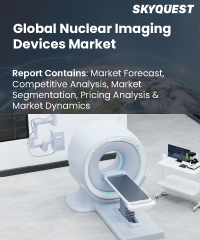
Report ID: SQMIG35A2604
Skyquest Technology's expert advisors have carried out comprehensive global market analysis on the nuclear imaging devices market, covering regional industry trends and market insights. Our team of analysts have conducted in-depth primary and secondary research to provide regional industry analysis and forecast of nuclear imaging devices market across North America, South America, Europe, Asia, the Middle East, and Africa.
The largest market region in the Nuclear Imaging Devices Market is currently North America. The region holds a significant share in the market due to its well-established healthcare infrastructure, high healthcare expenditure, and increasing awareness about early disease detection. Within North America, the US is the largest contributor to the market, driven by factors such as the rising prevalence of chronic diseases, high adoption of advanced imaging technologies, and a strong presence of key market players.
On the other hand, the fastest growing region in the Nuclear Imaging Devices Market is Asia Pacific. The region is experiencing significant growth due to several factors. Firstly, improving healthcare infrastructure and rising disposable income in countries like China, Japan, and India are driving the demand for advanced medical imaging technologies. Secondly, the increasing prevalence of chronic diseases in the region, along with a growing geriatric population, is fueling the adoption of nuclear imaging devices for early diagnosis and disease monitoring. Additionally, government initiatives aimed at improving healthcare facilities and rising awareness about the benefits of non-invasive diagnostic techniques are contributing to market growth.
REQUEST FOR SAMPLE
Want to customize this report? This report can be personalized according to your needs. Our analysts and industry experts will work directly with you to understand your requirements and provide you with customized data in a short amount of time. We offer $1000 worth of FREE customization at the time of purchase.
Feedback From Our Clients

Report ID: SQMIG35A2604
sales@skyquestt.com
USA +1 351-333-4748